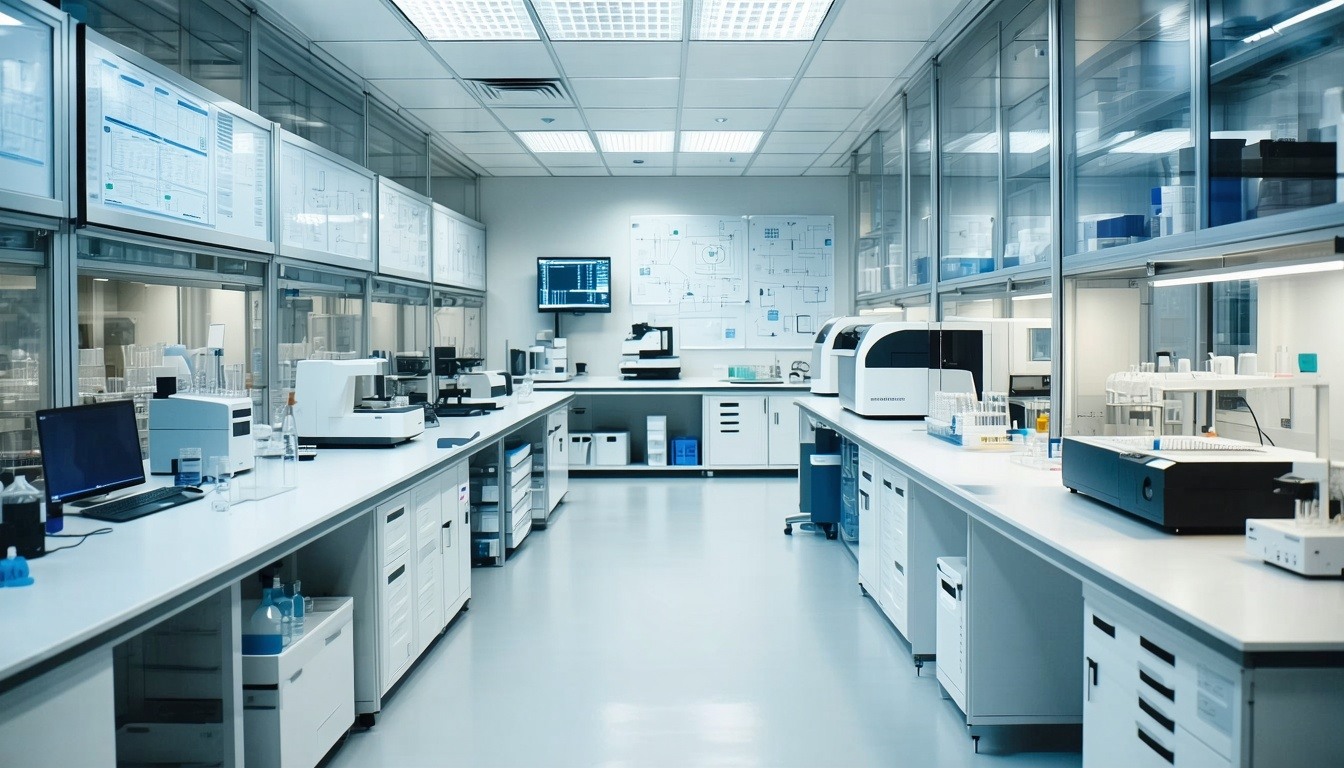Scientific research is at a turning point. As labs face tighter funding, rising operational costs, and mounting pressure to deliver breakthroughs faster, the margin for inefficiency is disappearing. But innovation isn’t limited to what happens under the microscope, it also shows up in the tools that power every step of the scientific process.
From AI-assisted pipettes to cloud-connected centrifuges, a new generation of lab tools is transforming how experiments are designed, executed, and analyzed. In this article, we highlight 10 innovative lab tools that are making research smarter, more scalable, and more precise in 2025.
Why innovation in lab tools matters
Whether it’s improving data accuracy, streamlining workflows, or unlocking new capabilities, new lab technologies empower scientists to work smarter. These tools are particularly impactful in high-stakes fields like drug development, diagnostics, and materials science, where efficiency, reproducibility, and regulatory compliance are non-negotiable.
R&D procurement professionals are also feeling the pressure to deliver more with less. By integrating next-gen tools, labs can reduce manual tasks, minimize sample loss, and ensure smoother operations across departments.
Read more: How to Properly Store and Maintain Lab Supplies to Reduce Costs
10 cutting-edge lab tools in 2025
These ten breakthrough lab tools represent key innovations across automation, data management, sample integrity, and molecular analysis.
-
AI-powered pipetting systems. These systems push lab automation to a new level, going beyond robotic accuracy by incorporating real-time decision-making and adaptive learning, optimizing volume transfers based on sample type, viscosity, or plate format. This technology is especially impactful in high-throughput screening (HTS), where speed and consistency are critical for identifying drug candidates.
Oxford Global reports how labs are increasingly integrating AI to guide liquid handling decisions and reduce variability in complex protocols. - RFID-enabled sample tracking. No more misplaced vials, RFID tagging offers real-time sample location data and integrates directly with lab inventory management software (LIMS), helping reduce losses, streamline inventory audits, and improve chain-of-custody documentation. Many biobanks and clinical research labs are turning to RFID to manage freezers, sample movement, and reagent usage.
- Benchtop genome sequencers. Not long ago, genome sequencing was the domain of large, centralized facilities. Today, compact benchtop sequencers are bringing that power directly to individual labs. These user-friendly systems enable researchers to perform targeted sequencing in-house, reducing turnaround times and costs. By keeping sequencing workflows on-site, labs can accelerate projects while maintaining control over their data.
- Cloud-integrated digital lab notebooks Electronic lab notebooks (ELNs) offer a streamlined, cloud-based approach to documenting experiments, making it easier for teams to collaborate in real-time, access data from anywhere, and maintain organized records. Features like version control, audit trails, and secure data storage not only enhance compliance with regulatory standards but also reduce the risk of data loss. By integrating with other digital tools and automating routine tasks, ELNs free up researchers to focus more on their science and less on administrative overhead.
Explore ZAGENO’s ELN and LIMS Integrations
- CRISPR kits for targeted gene editing. CRISPR remains a cornerstone of genetic research, and the availability of ready-to-use kits is making gene editing more accessible than ever. These streamlined tools enable both academic and commercial labs to conduct precise gene edits with greater efficiency.
For more: The Broad Institute is a key resource on CRISPR developments. - Smart centrifuges with IoT monitoring. Modern centrifuges have evolved beyond basic spin cycles. With IoT integration, these devices now offer real-time monitoring, predictive maintenance alerts, and seamless connectivity with lab management systems. This advancement helps labs minimize downtime, optimize performance, and make data-driven decisions for equipment management.
- Mini mass spectrometers. Mass spectrometry is no longer confined to large lab instruments. Compact, portable versions now enable chemical analysis in the field or at the point of care. These devices are particularly useful for environmental monitoring, forensic investigations, and on-site diagnostics, providing rapid results without the need for extensive lab infrastructure.
- Robotic liquid handlers. Automated liquid handling systems have become essential for tasks like high-throughput screening and serial dilutions. By minimizing manual pipetting, these robots reduce human error and increase efficiency, allowing researchers to focus more on data analysis and experimental design.
- Smart freezers with remote monitoring. Modern laboratory freezers now come equipped with smart features such as temperature tracking and remote alerts. These advancements help prevent sample loss due to equipment failure and assist in maintaining compliance with regulatory standards by providing detailed access logs and environmental data.
- AR/VR tools for lab training and collaboration. Augmented and virtual reality technologies are transforming lab training and collaboration. They offer immersive simulations for complex procedures, enabling safer and more effective learning experiences. These tools also facilitate remote collaboration, allowing teams to work together in virtual lab environments regardless of location.
The research impact: What's changed?
Collectively, these tools are changing how researchers work by making labs more digital, connected, and productive. By automating repetitive steps and enabling real-time collaboration, researchers can focus on hypothesis testing and breakthrough innovation.
Additionally, better lab tools lead to better science. Increased reproducibility, improved compliance, and faster data validation, all of which contribute to higher-quality outputs across life sciences.
Considerations for lab procurement teams
For procurement professionals, staying ahead of the innovation curve means balancing cost, value, and vendor reliability. When evaluating new lab tools, consider the following:
- Integration: Will the new tool work seamlessly with existing systems and workflows?
- Vendor transparency: Can you trust the specifications, service agreements, and support provided?
- Total cost of ownership: Beyond the purchase price, does the tool reduce labor, errors, or waste over time?
- Regulatory compliance: Does the product meet necessary industry standards and certifications?
- Supply chain resilience: Is the vendor capable of providing consistent supply and handling backorders efficiently?
- Sustainability: Does the product align with your organization's environmental and sustainability goals?
Smart procurement isn't just about acquiring new tools; it's about ensuring they contribute to long-term efficiency, compliance, and innovation.
ZAGENO's Top Lab Products of 2024: Discover the most popular lab tools purchased on our platform.
How ZAGENO supports scientific innovation
Whether you're seeking innovative technology or essential lab staples, ZAGENO helps you spend less time sourcing and more time discovering.
At ZAGENO, we recognize the complexities involved in sourcing lab supplies and scientific tools. Our R&D lab supply procurement platform simplifies procurement by offering a:
- Centralized marketplace: Access and purchase from over 40 million products from more than 5,000 trusted suppliers in one place, one cart, and one monthly invoice.
- Comprehensive product comparisons: Evaluate tools side-by-side based on specifications, pricing, and supplier service level information to make informed decisions tailored to your lab's needs.
- Integrated approval workflows: Utilize built-in workflows that align with your organization's procurement policies, enhancing budget visibility and compliance.
- Real-time spend analytics: Monitor expenditures with real-time dashboards, enabling better budget management and financial planning.
- Seamless system integration: Integrate ZAGENO with your existing ERP and P2P platforms to ensure a cohesive and efficient purchasing experience.
By leveraging ZAGENO's comprehensive platform, procurement teams can enhance operational efficiency, reduce administrative burdens, and focus more on advancing scientific research.
Explore How to Choose a Lab Supply Marketplace
Embrace innovation in your lab
Innovation in lab tools isn’t a trend; it’s a catalyst for discovery. As life sciences evolve, so must the instruments that power them. By embracing these advancements, labs position themselves for greater impact, efficiency, and scientific excellence.








